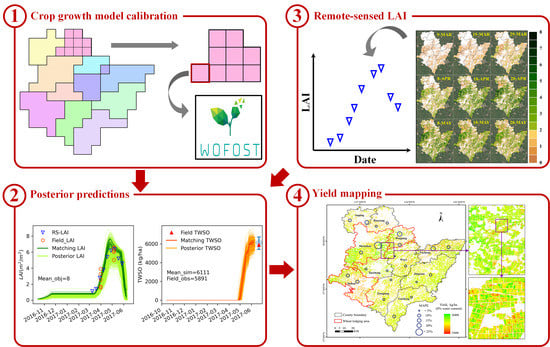Bayesian Posterior-Based Winter Wheat Yield Estimation at the Field Scale through Assimilation of Sentinel-2 Data into WOFOST Model
Abstract
:1. Introduction
2. Data
2.1. County-Level Yield Statistics
2.2. Field Observation Data
2.3. Remote-Sensing Data
2.4. Meteorological Data
3. Methods
3.1. WOFOST Model
3.2. DREAM Algorithm
3.3. Remote-Sensing NDVI-Based LAI Inversion
3.4. Yield Estimates Based on Bayesian Posterior Ensembles and Remote-Sensing LAI
3.5. Statistical Evaluation
4. Results
4.1. Remotely Sensed LAI
4.2. Bayesian Posterior Uncertainty Exploration of WOFOST with DREAM Method
4.3. Yield Estimation Accuracy Evaluation and Uncertainty Analysis
5. Discussion
5.1. Can Yield Variability Be Explained by LAI?
5.2. The Role of County-Level Yield Statistics and Their Potential Improvement
5.3. Multiple Remote-Sensing Variables Matching-Based Yield Estimates
6. Conclusions
Author Contributions
Funding
Data Availability Statement
Acknowledgments
Conflicts of Interest
References
- Benami, E.; Jin, Z.; Carter, M.R.; Ghosh, A.; Hijmans, R.J.; Hobbs, A.; Kenduiywo, B.; Lobell, D.B. Uniting remote sensing, crop modelling and economics for agricultural risk management. Nat. Rev. Earth Environ. 2021, 2, 140–159. [Google Scholar] [CrossRef]
- Moulin, S.; Bondeau, A.; Delecolle, R. Combining agricultural crop models and satellite observations: From field to regional scales. Int. J. Remote Sens. 1998, 19, 1021–1036. [Google Scholar] [CrossRef]
- Jin, X.; Kumar, L.; Li, Z.; Feng, H.; Xu, X.; Yang, G.; Wang, J. A review of data assimilation of remote sensing and crop models. Eur. J. Agron. 2018, 92, 141–152. [Google Scholar] [CrossRef]
- Huang, J.; Gómez-Dans, J.L.; Huang, H.; Ma, H.; Wu, Q.; Lewis, P.E.; Liang, S.; Chen, Z.; Xue, J.; Wu, Y.; et al. Assimilation of remote sensing into crop growth models: Current status and perspectives. Agr. Forest Meteorol. 2019, 276–277, 107609. [Google Scholar] [CrossRef]
- Basso, B.; Cammarano, D.; Carfagna, E. Review of crop yield forecasting methods and early warning systems. In Proceedings of the First Meeting of the Scientific Advisory Committee of the Global Strategy to Improve Agricultural and Rural Statistics, Rome, Italy, 18–19 July 2013; FAO Headquarters: Rome, Italy, 2013. [Google Scholar]
- Fritz, S.; See, L.; Bayas, J.C.L.; Waldner, F.; Jacques, D.; Becker-Reshef, I.; Whitcraft, A.; Baruth, B.; Bonifacio, R.; Crutchfield, J.; et al. A comparison of global agricultural monitoring systems and current gaps. Agr. Syst. 2019, 168, 258–272. [Google Scholar] [CrossRef]
- Maestrini, B.; Basso, B. Predicting spatial patterns of within-field crop yield variability. Field Crops Res. 2018, 219, 106–112. [Google Scholar] [CrossRef]
- Hunt, M.L.; Blackburn, G.A.; Carrasco, L.; Redhead, J.W.; Rowland, C.S. High resolution wheat yield mapping using Sentinel-2. Remote Sens. Environ. 2019, 233, 111410. [Google Scholar] [CrossRef]
- Kayad, A.; Sozzi, M.; Gatto, S.; Marinello, F.; Pirotti, F. Monitoring Within-Field Variability of Corn Yield using Sentinel-2 and Machine Learning Techniques. Remote Sens. 2019, 11, 2873. [Google Scholar] [CrossRef] [Green Version]
- Skakun, S.; Kalecinski, N.I.; Brown, M.G.L.; Johnson, D.M.; Vermote, E.F.; Roger, J.; Franch, B. Assessing within-Field Corn and Soybean Yield Variability from WorldView-3, Planet, Sentinel-2, and Landsat 8 Satellite Imagery. Remote Sens. 2021, 13, 872. [Google Scholar] [CrossRef]
- Segarra, J.; Araus, J.L.; Kefauver, S.C. Farming and Earth Observation: Sentinel-2 data to estimate within-field wheat grain yield. Int. J. Appl. Earth Obs. 2022, 107, 102697. [Google Scholar] [CrossRef]
- de Wit, A.; Boogaard, H.; Fumagalli, D.; Janssen, S.; Knapen, R.; van Kraalingen, D.; Supit, I.; van der Wijngaart, R.; van Diepen, K. 25 years of the WOFOST cropping systems model. Agr. Syst. 2019, 168, 154–167. [Google Scholar] [CrossRef]
- Jones, J.W.; Hoogenboom, G.; Porter, C.H.; Boote, K.J.; Batchelor, W.D.; Hunt, L.A.; Wilkens, P.W.; Singh, U.; Gijsman, A.J.; Ritchie, J.T. The DSSAT cropping system model. Eur. J. Agron. 2003, 18, 235–265. [Google Scholar] [CrossRef]
- Keating, B.A.; Carberry, P.S.; Hammer, G.L.; Probert, M.E.; Robertson, M.J.; Holzworth, D.; Huth, N.I.; Hargreaves, J.N.G.; Meinke, H.; Hochman, Z.; et al. An overview of APSIM, a model designed for farming systems simulation. Eur. J. Agron. 2003, 18, 267–288. [Google Scholar] [CrossRef] [Green Version]
- Holzworth, D.P.; Snow, V.; Janssen, S.; Athanasiadis, I.N.; Donatelli, M.; Hoogenboom, G.; White, J.W.; Thorburn, P. Agricultural production systems modelling and software: Current status and future prospects. Environ. Model. Softw. Environ. Data News 2015, 72, 276–286. [Google Scholar] [CrossRef]
- Zhuo, W.; Fang, S.; Gao, X.; Wang, L.; Wu, D.; Fu, S.; Wu, Q.; Huang, J. Crop yield prediction using MODIS LAI, TIGGE weather forecasts and WOFOST model: A case study for winter wheat in Hebei, China during 2009–2013. Int. J. Appl. Earth Obs. 2022, 106, 102668. [Google Scholar] [CrossRef]
- Huang, J.; Ma, H.; Sedano, F.; Lewis, P.; Liang, S.; Wu, Q.; Su, W.; Zhang, X.; Zhu, D. Evaluation of regional estimates of winter wheat yield by assimilating three remotely sensed reflectance datasets into the coupled WOFOST–PROSAIL model. Eur. J. Agron. 2019, 102, 1–13. [Google Scholar] [CrossRef]
- Huang, J.; Sedano, F.; Huang, Y.; Ma, H.; Li, X.; Liang, S.; Tian, L.; Zhang, X.; Fan, J.; Wu, W. Assimilating a synthetic Kalman filter leaf area index series into the WOFOST model to improve regional winter wheat yield estimation. Agr. Forest Meteorol. 2016, 216, 188–202. [Google Scholar] [CrossRef]
- Huang, H.; Huang, J.; Li, X.; Zhuo, W.; Wu, Y.; Niu, Q.; Su, W.; Yuan, W. A dataset of winter wheat aboveground biomass in China during 2007–2015 based on data assimilation. Sci. Data 2022, 9, 200. [Google Scholar] [CrossRef]
- Kang, Y.; Özdoğan, M. Field-level crop yield mapping with Landsat using a hierarchical data assimilation approach. Remote Sens. Environ. 2019, 228, 144–163. [Google Scholar] [CrossRef]
- Ji, F.; Meng, J.; Cheng, Z.; Fang, H.; Wang, Y. Crop Yield Estimation at Field Scales by Assimilating Time Series of Sentinel-2 Data Into a Modified CASA-WOFOST Coupled Model. IEEE Trans. Geosci. Remote Sens. 2021, 60, 4400914. [Google Scholar] [CrossRef]
- Silvestro, P.; Pignatti, S.; Pascucci, S.; Yang, H.; Li, Z.; Yang, G.; Huang, W.; Casa, R. Estimating Wheat Yield in China at the Field and District Scale from the Assimilation of Satellite Data into the Aquacrop and Simple Algorithm for Yield (SAFY) Models. Remote Sens. 2017, 9, 509. [Google Scholar] [CrossRef] [Green Version]
- Manivasagam, V.S.; Sadeh, Y.; Kaplan, G.; Bonfil, D.J.; Rozenstein, O. Studying the Feasibility of Assimilating Sentinel-2 and PlanetScope Imagery into the SAFY Crop Model to Predict Within-Field Wheat Yield. Remote Sens. 2021, 13, 2395. [Google Scholar] [CrossRef]
- Gaso, D.V.; de Wit, A.; Berger, A.G.; Kooistra, L. Predicting within-field soybean yield variability by coupling Sentinel-2 leaf area index with a crop growth model. Agr. Forest Meteorol 2021, 308–309, 108553. [Google Scholar] [CrossRef]
- Ziliani, M.G.; Altaf, M.U.; Aragon, B.; Houburg, R.; Franz, T.E.; Lu, Y.; Sheffield, J.; Hoteit, I.; McCabe, M.F. Early season prediction of within-field crop yield variability by assimilating CubeSat data into a crop model. Agr. Forest Meteorol. 2022, 313, 108736. [Google Scholar] [CrossRef]
- Dong, J.; Fu, Y.; Wang, J.; Tian, H.; Fu, S.; Niu, Z.; Han, W.; Zheng, Y.; Huang, J.; Yuan, W. Early-season mapping of winter wheat in China based on Landsat and Sentinel images. Earth Syst. Sci. Data 2020, 12, 3081–3095. [Google Scholar] [CrossRef]
- Zhao, G.; He, D.; Yao, S. Heibei Rural Statistical Yearbook 2017; China Statistics Press: Beijing, China, 2017. [Google Scholar]
- Zhao, G.; He, D.; Yao, S. Heibei Rural Statistical Yearbook 2018; China Statistics Press: Beijing, China, 2018. [Google Scholar]
- Hersbach, H.; Bell, B.; Berrisford, P.; Hirahara, S.; Hor, A.; Nyi, A.A.S.; Mu, N.; Oz-Sabater, J.I.N.; Nicolas, J.; Peubey, C.; et al. The ERA5 global reanalysis. Q. J. R. Meteorol. Soc. 2020, 146, 1999–2049. [Google Scholar] [CrossRef]
- de Wit, A.; Boogaard, H.L.; Supit, I.; van den Berg, M. System Description of the WOFOST 7.2 Cropping Systems Model.; Wageningen Environmental Research: Wageningen, The Netherlands, 2020. [Google Scholar]
- Vrugt, J.A. Markov chain Monte Carlo simulation using the DREAM software package: Theory, concepts, and MATLAB implementation. Environ. Model. Softw. Environ. Data News 2016, 75, 273–316. [Google Scholar] [CrossRef] [Green Version]
- Laloy, E.; Vrugt, J.A. High-dimensional posterior exploration of hydrologic models using multiple-try DREAM (ZS) and high-performance computing. Water Resour. Res. 2012, 48, W01526. [Google Scholar] [CrossRef] [Green Version]
- Gelman, A.; Carlin, J.B.; Stern, H.S.; Dunson, D.B.; Vehtari, A.; Rubin, D.B. Bayesian Data Analysis; CRC Press: Boca Raton, FL, USA, 2013. [Google Scholar]
- Vrugt, J.A.; Ter Braak, C.J.F.; Diks, C.G.H.; Robinson, B.A.; Hyman, J.M.; Higdon, D. Accelerating Markov Chain Monte Carlo Simulation by Differential Evolution with Self-Adaptive Randomized Subspace Sampling. Int. J. Nonlin. Sci. Num. 2009, 10, 273–290. [Google Scholar] [CrossRef]
- Houska, T.; Kraft, P.; Chamorro-Chavez, A.; Breuer, L. SPOTting Model Parameters Using a Ready-Made Python Package. PLoS ONE 2015, 10, e145180. [Google Scholar] [CrossRef]
- Baret, F.; Guyot, G. Potentials and limits of vegetation indices for LAI and APAR assessment. Remote Sens. Environ. 1991, 35, 161–173. [Google Scholar] [CrossRef]
- Chauhan, S.; Darvishzadeh, R.; Boschetti, M.; Pepe, M.; Nelson, A. Remote sensing-based crop lodging assessment: Current status and perspectives. ISPRS J. Photogramm. 2019, 151, 124–140. [Google Scholar] [CrossRef] [Green Version]
- Karthikeyan, L.; Chawla, I.; Mishra, A.K. A review of remote sensing applications in agriculture for food security: Crop growth and yield, irrigation, and crop losses. J. Hydrol. 2020, 586, 124905. [Google Scholar] [CrossRef]
- Wang, X.; Huang, J.; Feng, Q.; Yin, D. Winter Wheat Yield Prediction at County Level and Uncertainty Analysis in Main Wheat-Producing Regions of China with Deep Learning Approaches. Remote Sens. 2020, 12, 1744. [Google Scholar] [CrossRef]
- Lin, T.; Zhong, R.; Wang, Y.; Xu, J.; Jiang, H.; Xu, J.; Ying, Y.; Rodriguez, L.; Ting, K.C.; Li, H. DeepCropNet: A deep spatial-temporal learning framework for county-level corn yield estimation. Environ. Res. Lett. 2020, 15, 34016. [Google Scholar] [CrossRef]
- Jiang, H.; Hu, H.; Zhong, R.; Xu, J.; Xu, J.; Huang, J.; Wang, S.; Ying, Y.; Lin, T. A deep learning approach to conflating heterogeneous geospatial data for corn yield estimation: A case study of the US Corn Belt at the county level. Glob. Chang. Biol. 2020, 26, 1754–1766. [Google Scholar] [CrossRef] [PubMed]
- Zhuo, W.; Huang, J.; Xiao, X.; Huang, H.; Bajgain, R.; Wu, X.; Gao, X.; Wang, J.; Li, X.; Wagle, P. Assimilating remote sensing-based VPM GPP into the WOFOST model for improving regional winter wheat yield estimation. Eur. J. Agron. 2022, 139, 126556. [Google Scholar] [CrossRef]
- Huang, J.; Tian, L.; Liang, S.; Ma, H.; Becker-Reshef, I.; Huang, Y.; Su, W.; Zhang, X.; Zhu, D.; Wu, W. Improving winter wheat yield estimation by assimilation of the leaf area index from Landsat TM and MODIS data into the WOFOST model. Agr. Forest Meteorol. 2015, 204, 106–121. [Google Scholar] [CrossRef] [Green Version]
- Zhuo, W.; Huang, J.; Li, L.; Zhang, X.; Ma, H.; Gao, X.; Huang, H.; Xu, B.; Xiao, X. Assimilating Soil Moisture Retrieved from Sentinel-1 and Sentinel-2 Data into WOFOST Model to Improve Winter Wheat Yield Estimation. Remote Sens. 2019, 11, 1618. [Google Scholar] [CrossRef] [Green Version]
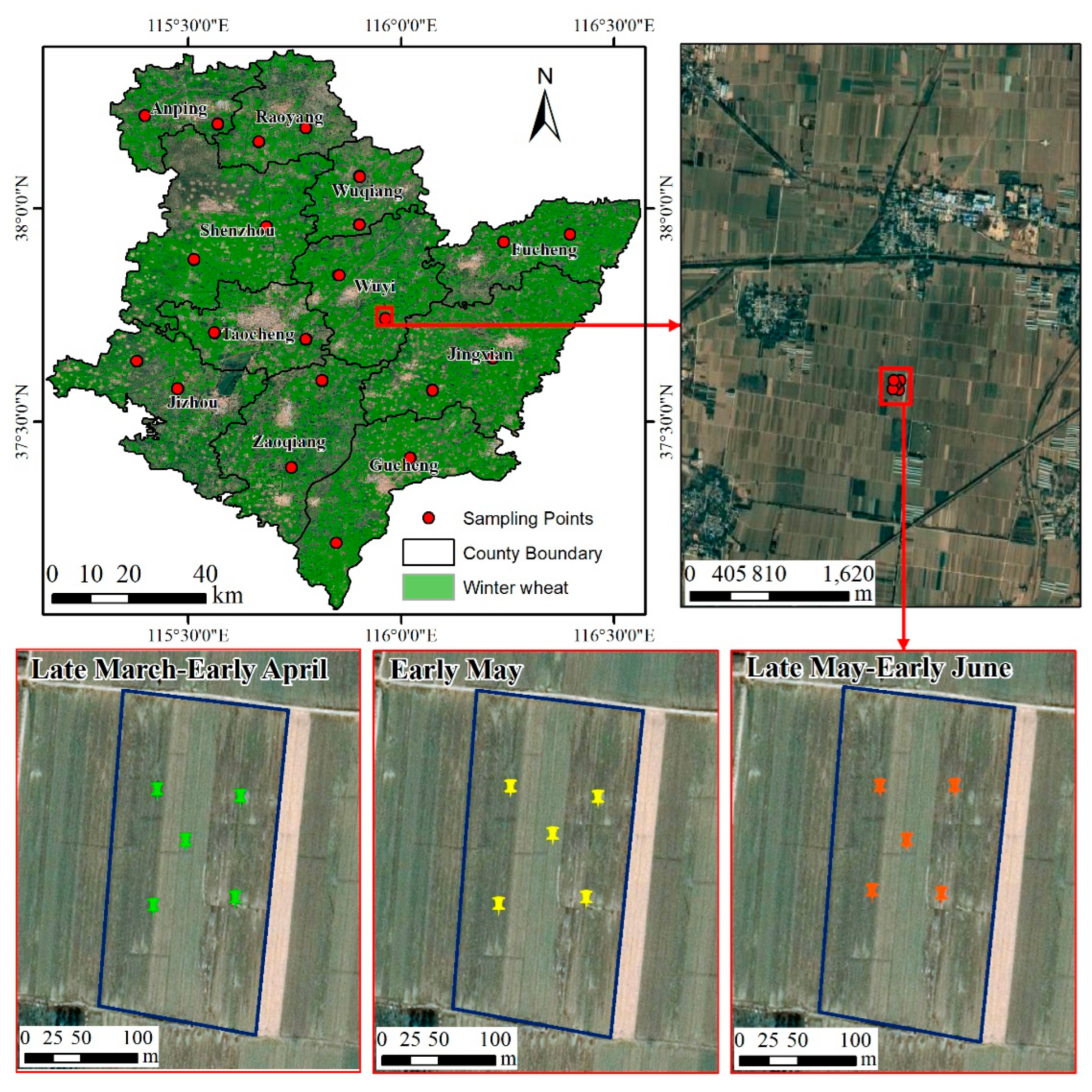
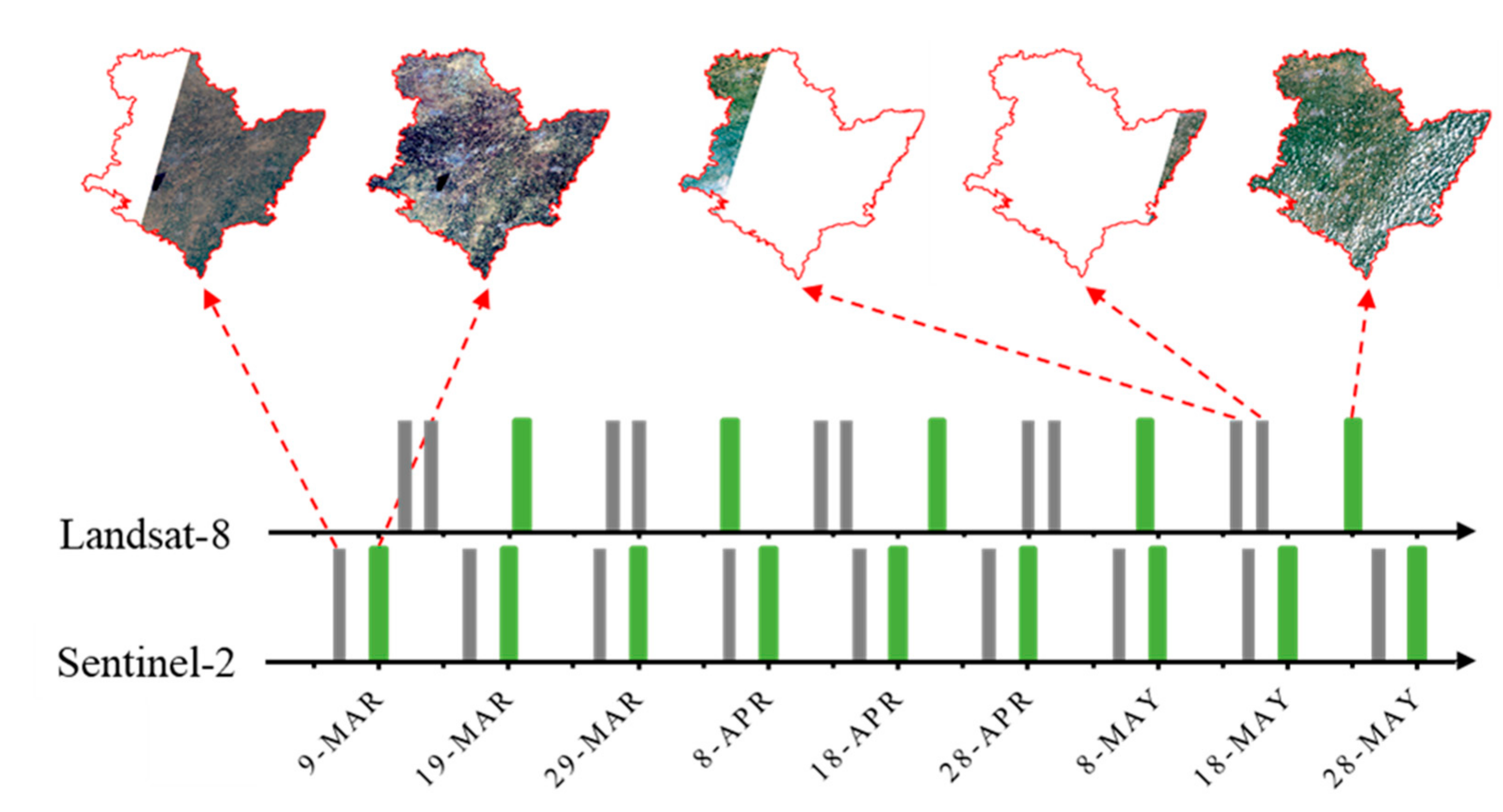
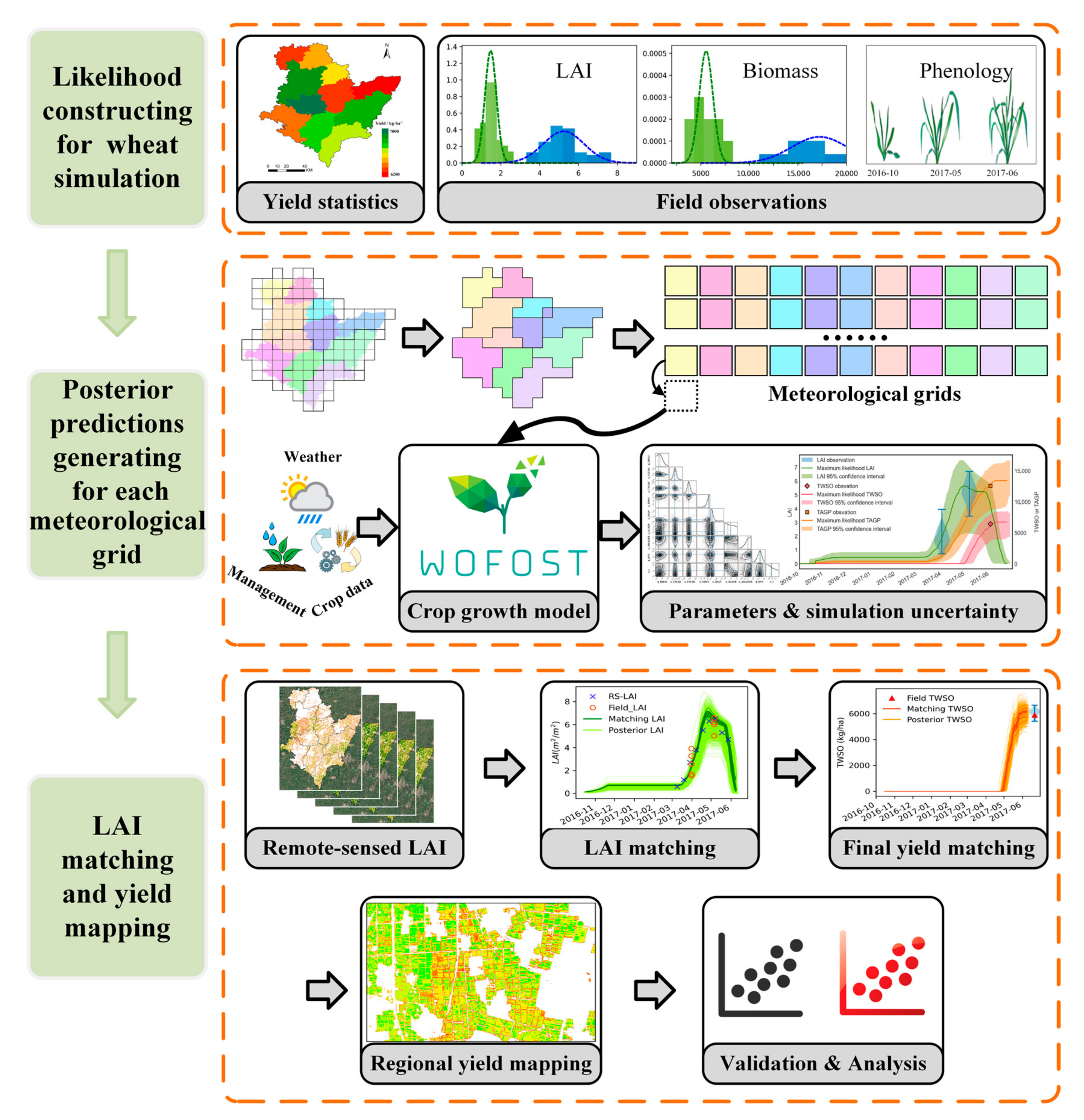
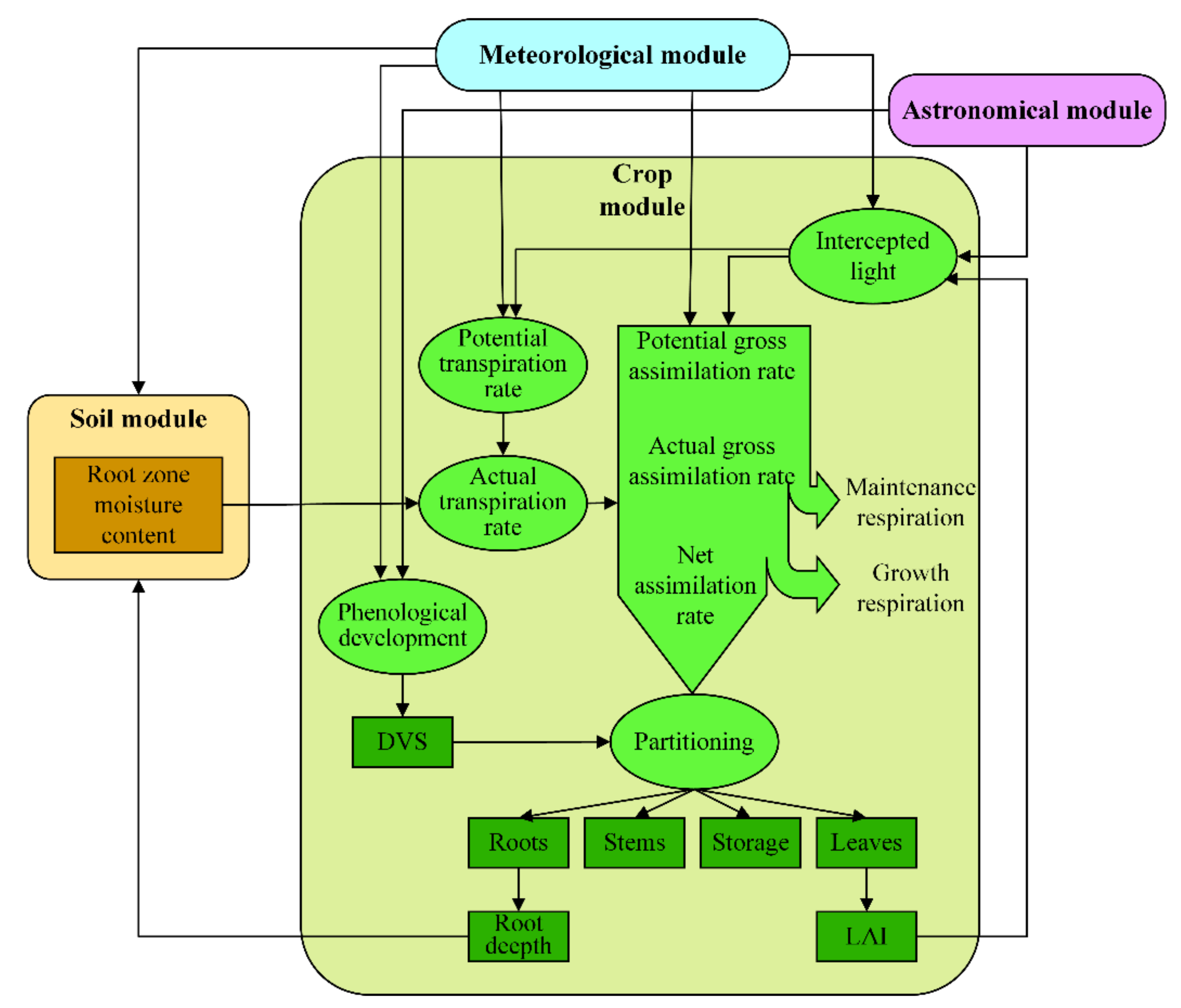

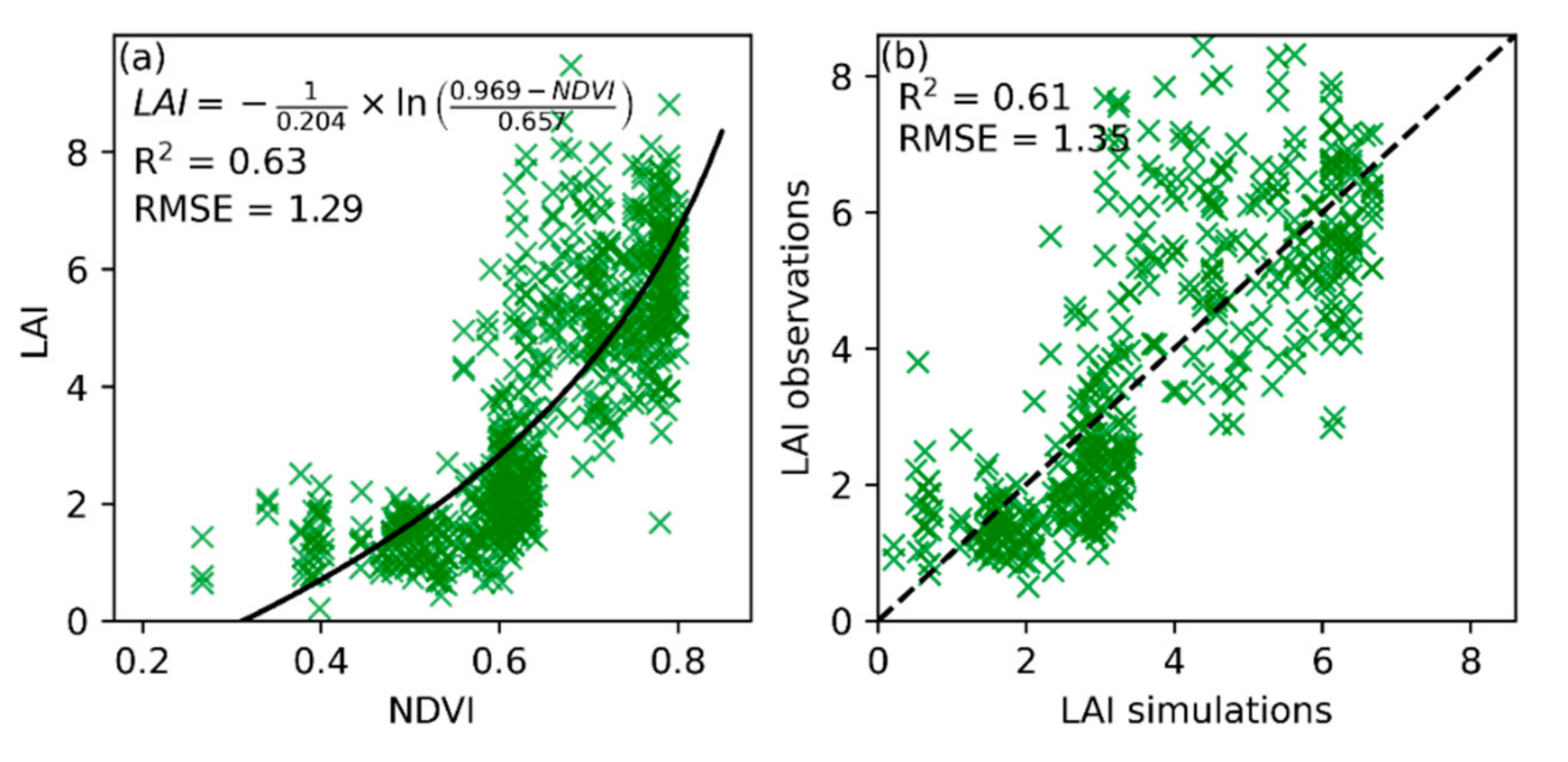
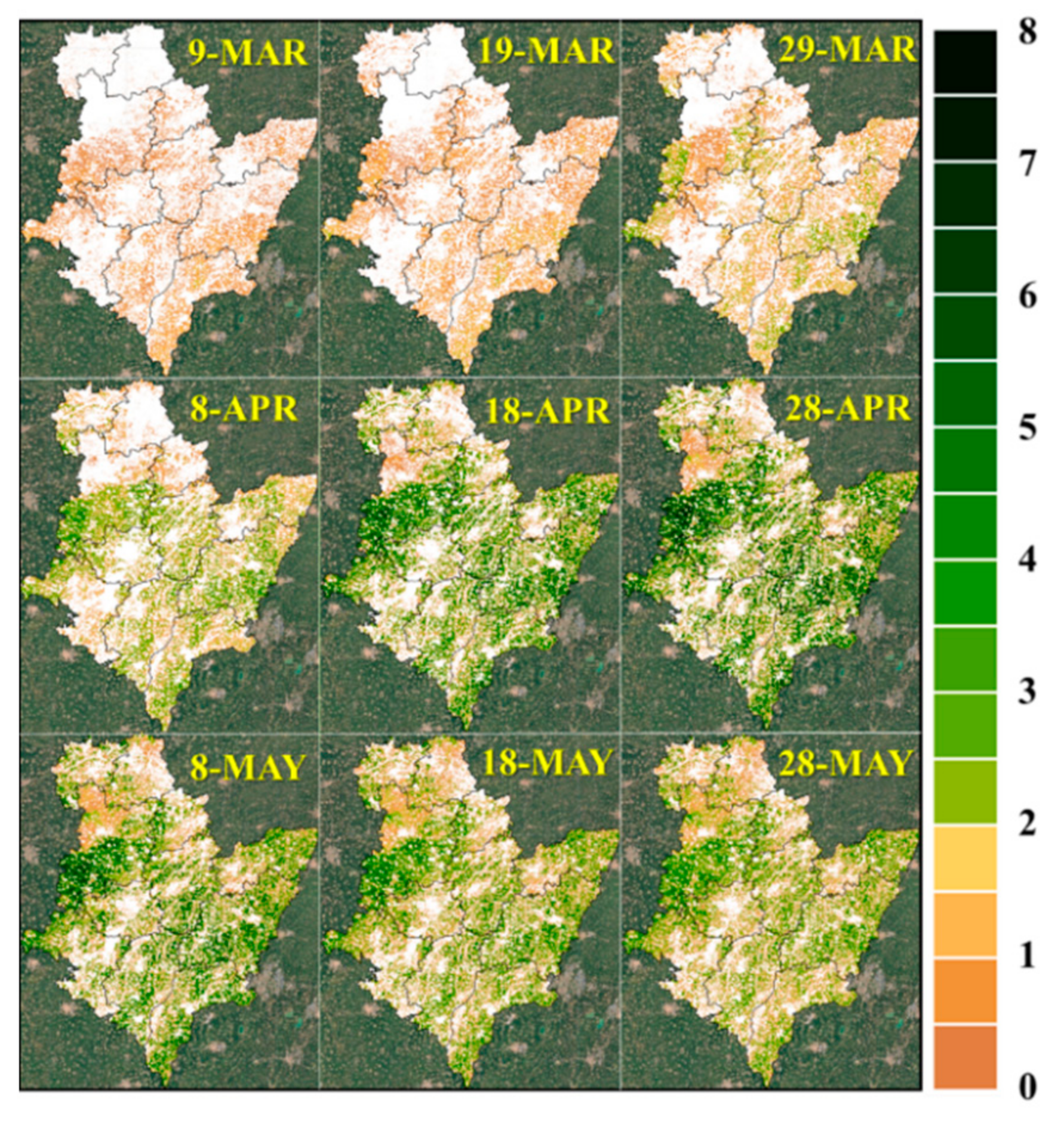

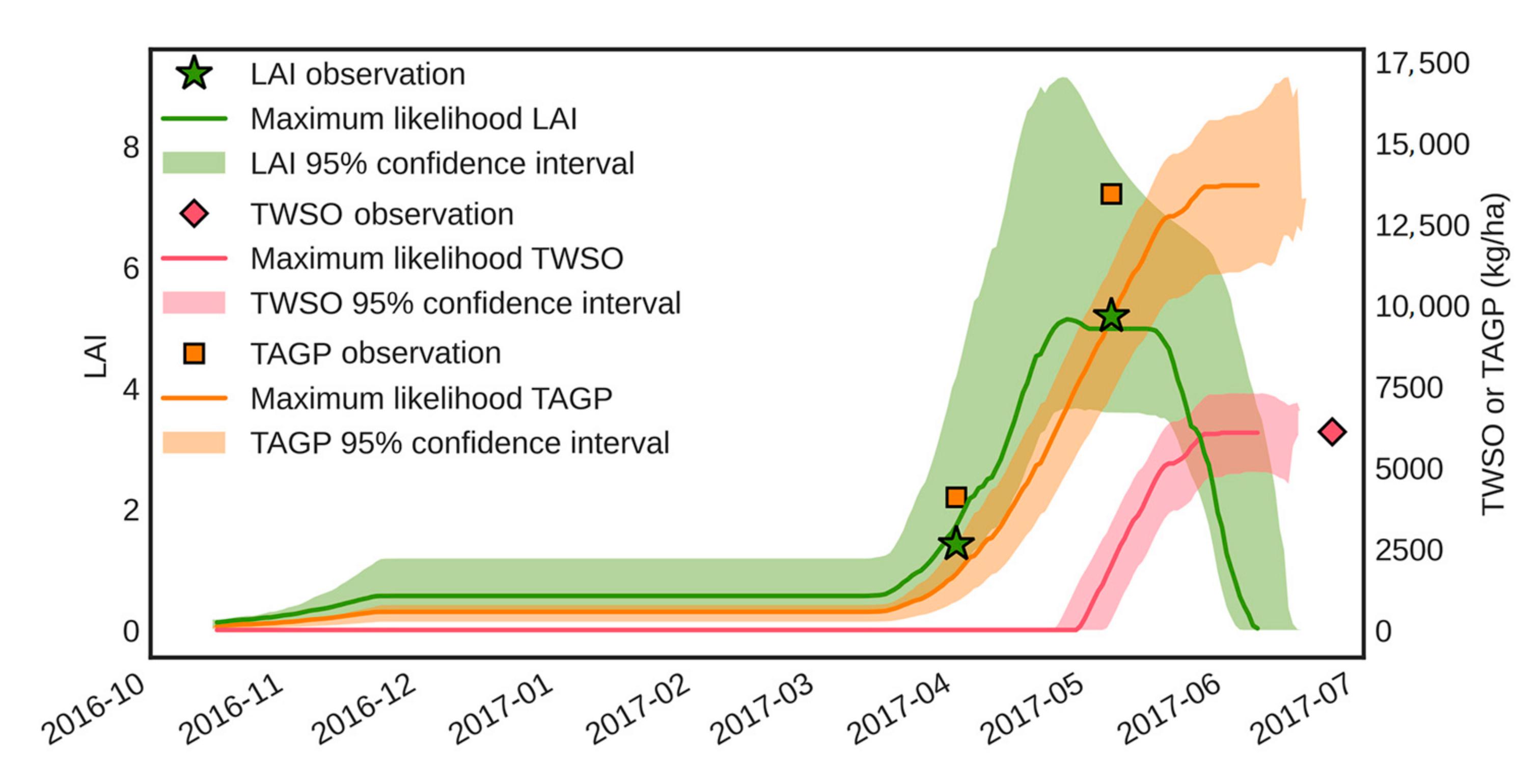

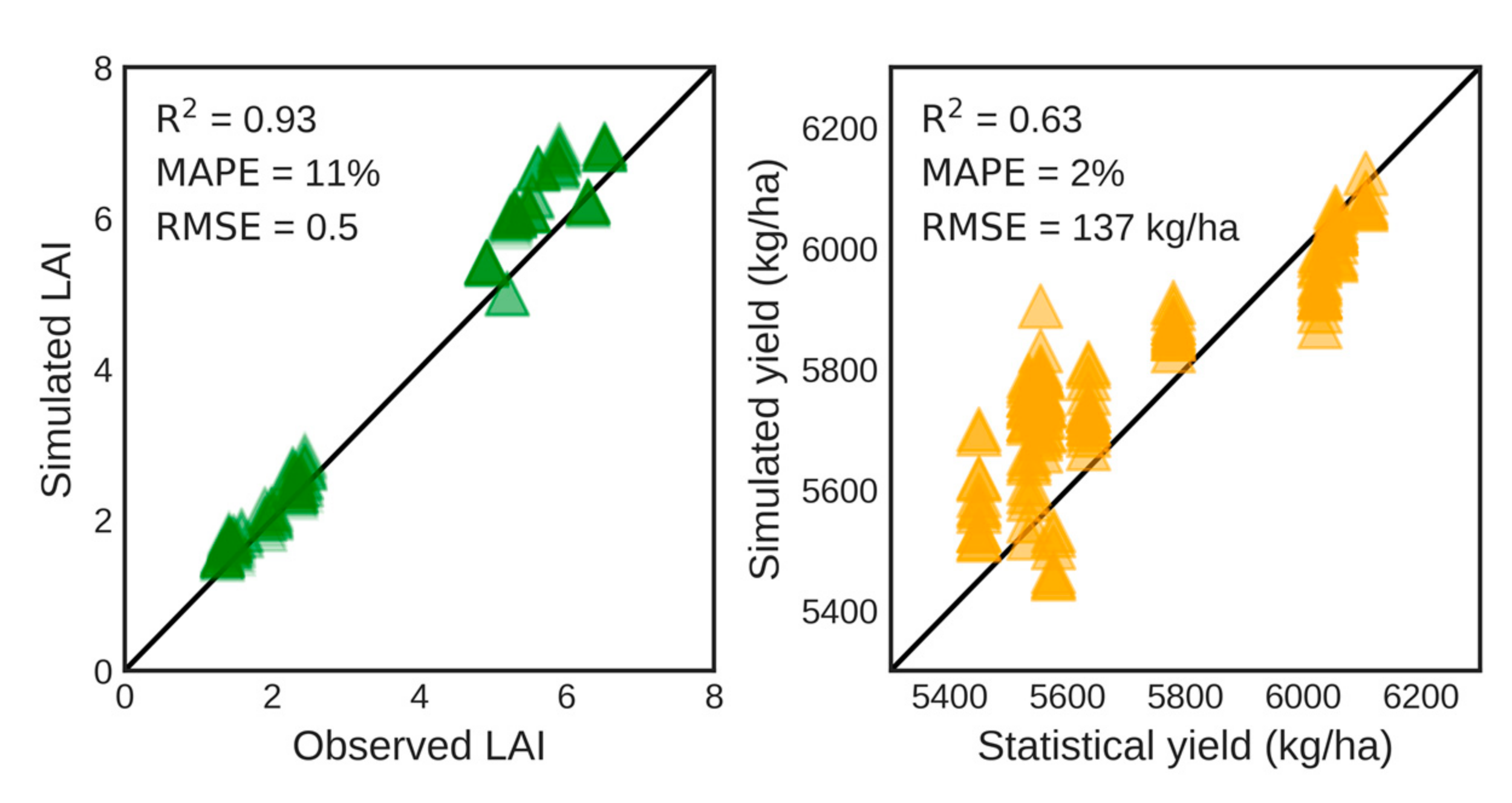


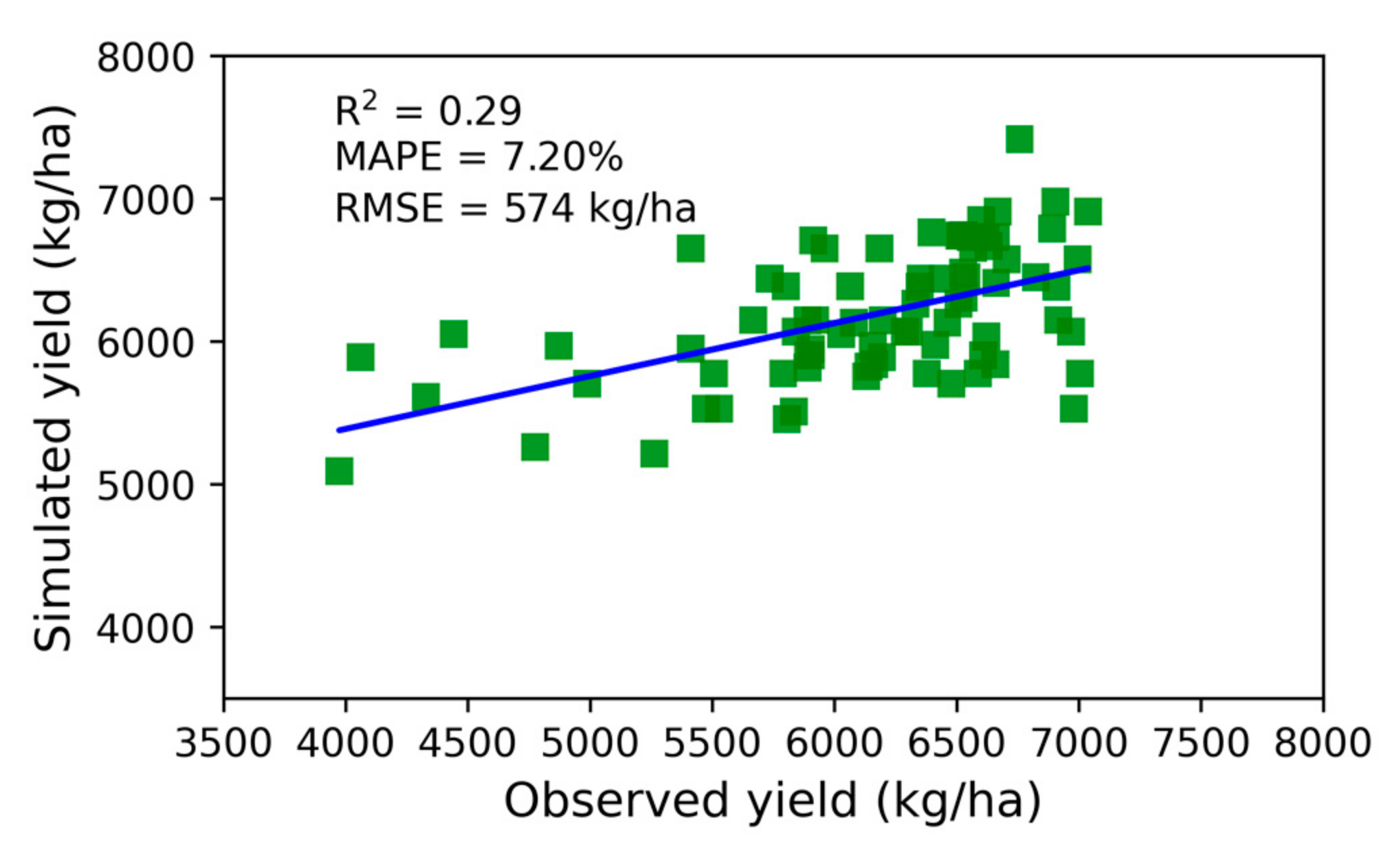
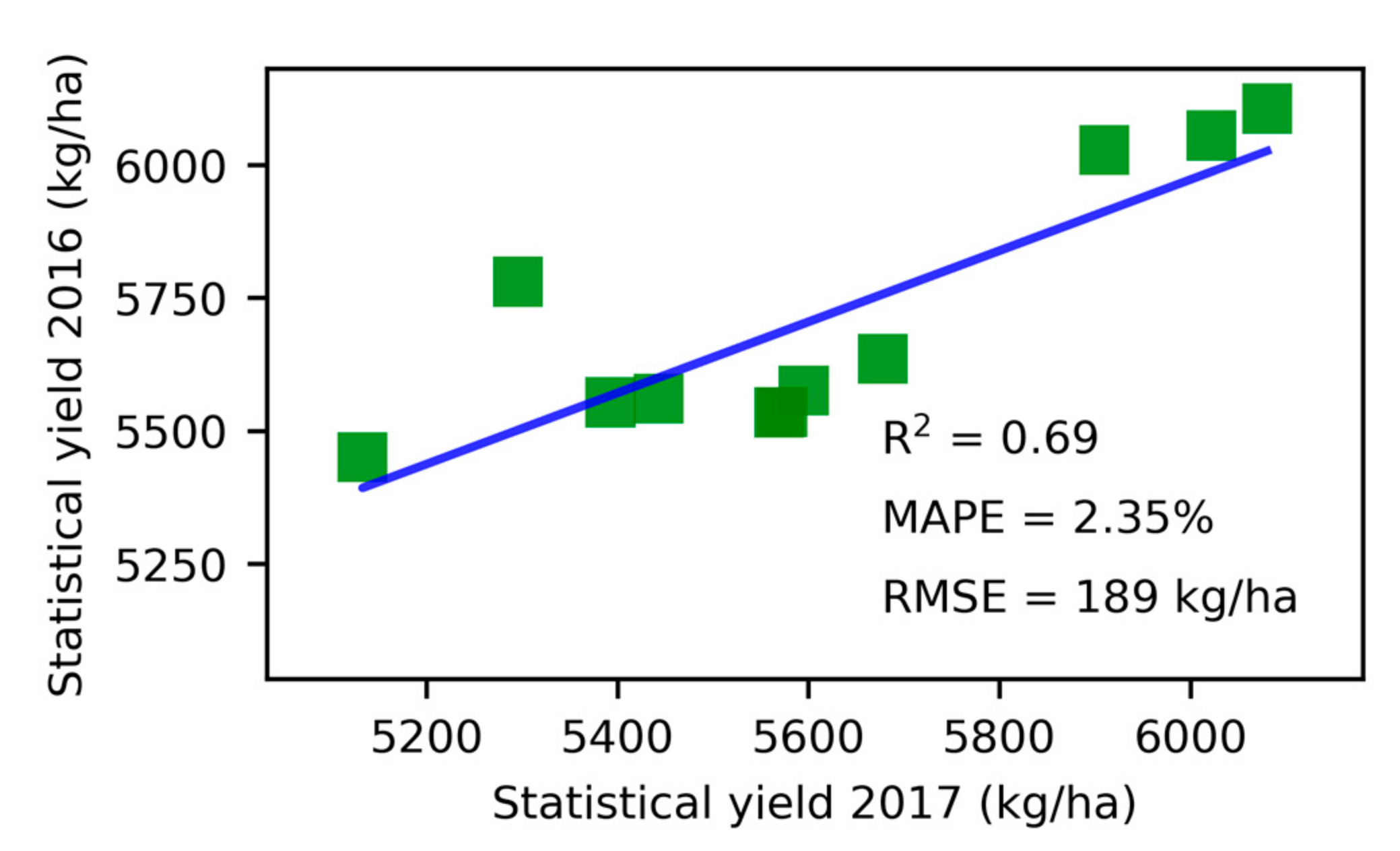
| Parameters | Description | Initial Values | Optimized Values and Implementation |
|---|---|---|---|
| IDEM | Emergence date | 19 October 2016 | 19 October 2016 + β_IDEM |
| TSUM1 | The thermal time from emergence to anthesis | 650 | 650 × α_TSUM1 |
| TSUM2 | The thermal time from anthesis to maturity | 950 | 950 × α_TSUM2 |
| TDWI | Initial total crop dry weight | 50 | 50.0 × α_TDWI |
| SPAN | The life span of leaves growing at an average temperature of 35 °C | 31.3 | 31.3 × α_SPAN |
| SLATB | Specific leaf area as a function of development stage | [0.00, 0.00212, | [0.00, 0.00212 × α_SLATB, |
| 0.50, 0.00212, | 0.50, 0.00212 × α_SLATB, | ||
| 2.00, 0.00212] | 2.00, 0.00212 × α_SLATB] | ||
| AMAXTB | Maximum CO2 assimilation rate as a function of development stage of the crop | [0.00, 35.83, | [0.00, 35.83 × α_AMAXTB, |
| 1.00, 35.83, | 1.00, 35.83 × α_AMAXTB, | ||
| 1.30, 35.83, | 1.30, 35.83 × α_AMAXTB, | ||
| 2.00, 4.48] | 2.00, 4.48 × α_AMAXTB] | ||
| FLTB | Fraction of total dry matter to leaves as a function of DVS | [0.000, 0.650, | [0.000, 0.650 × α_v, |
| 0.100, 0.650, | 0.100, 0.650 × α_v, | ||
| 0.250, 0.700, | 0.250, 0.700 × α_v, | ||
| 0.500, 0.500, | 0.500, 0.500 × α_v, | ||
| 0.646, 0.300, | 0.646, 0.300 × α_v, | ||
| 0.950, 0.000, | 0.950 + β_DVS, 0.000, | ||
| 2.000, 0.000] | 2.000, 0.000] | ||
| FOTB | Fraction of total dry matter to storage organs as a function of DVS | [0.000, 0.000, | [0.000, 0.000, |
| 0.950, 0.000, | 0.950 + β_DVS, 0.000, | ||
| 1.000, 1.000, | 1.000 + β_DVS, 1.000, | ||
| 2.000, 1.000] | 2.000, 1.000] | ||
| FSTB | Fraction of total dry matter to stems as a function of DVS | [0.000, 0.350, | [0.000, 1 − 0.650 × α_v, |
| 0.100, 0.350, | 0.100, 1 − 0.650 × α_v, | ||
| 0.250, 0.300, | 0.250, 1 − 0.700 × α_v, | ||
| 0.500, 0.500, | 0.500, 1 − 0.500 × α_v, | ||
| 0.646, 0.700, | 0.646, 1 − 0.700 × α_v, | ||
| 0.950, 1.000, | 0.950 + β_DVS, 1.000, | ||
| 1.000, 0.000, | 1.000 + β_DVS, 0.000, | ||
| 2.000, 0.000] | 2.000, 0.000] |
| Optimized Variables | First Guess | Lower Bound | Upper Bound |
|---|---|---|---|
| β_IDEM | 0 | −5 | 5 |
| α_TSUM1 | 1 | 0.5 | 1.5 |
| α_TSUM2 | 1 | 0.5 | 1.5 |
| α_TDWI | 1 | 0 | 5 |
| α_SPAN | 1 | 0.8 | 2.0 |
| α_SLATB | 1 | 0.8 | 1.2 |
| α_AMAXTB | 1 | 0.8 | 1.2 |
| α_v | 1 | 0.8 | 1.2 |
| β_DVS | 0 | −0.2 | 0.2 |
| LAI | Yield |
|---|---|
| Yield1 | |
| Yield2 | |
| Yieldm−1 | |
| Yieldm |
Publisher’s Note: MDPI stays neutral with regard to jurisdictional claims in published maps and institutional affiliations. |
© 2022 by the authors. Licensee MDPI, Basel, Switzerland. This article is an open access article distributed under the terms and conditions of the Creative Commons Attribution (CC BY) license (https://creativecommons.org/licenses/by/4.0/).
Share and Cite
Wu, Y.; Xu, W.; Huang, H.; Huang, J. Bayesian Posterior-Based Winter Wheat Yield Estimation at the Field Scale through Assimilation of Sentinel-2 Data into WOFOST Model. Remote Sens. 2022, 14, 3727. https://doi.org/10.3390/rs14153727
Wu Y, Xu W, Huang H, Huang J. Bayesian Posterior-Based Winter Wheat Yield Estimation at the Field Scale through Assimilation of Sentinel-2 Data into WOFOST Model. Remote Sensing. 2022; 14(15):3727. https://doi.org/10.3390/rs14153727
Chicago/Turabian StyleWu, Yantong, Wenbo Xu, Hai Huang, and Jianxi Huang. 2022. "Bayesian Posterior-Based Winter Wheat Yield Estimation at the Field Scale through Assimilation of Sentinel-2 Data into WOFOST Model" Remote Sensing 14, no. 15: 3727. https://doi.org/10.3390/rs14153727
APA StyleWu, Y., Xu, W., Huang, H., & Huang, J. (2022). Bayesian Posterior-Based Winter Wheat Yield Estimation at the Field Scale through Assimilation of Sentinel-2 Data into WOFOST Model. Remote Sensing, 14(15), 3727. https://doi.org/10.3390/rs14153727






